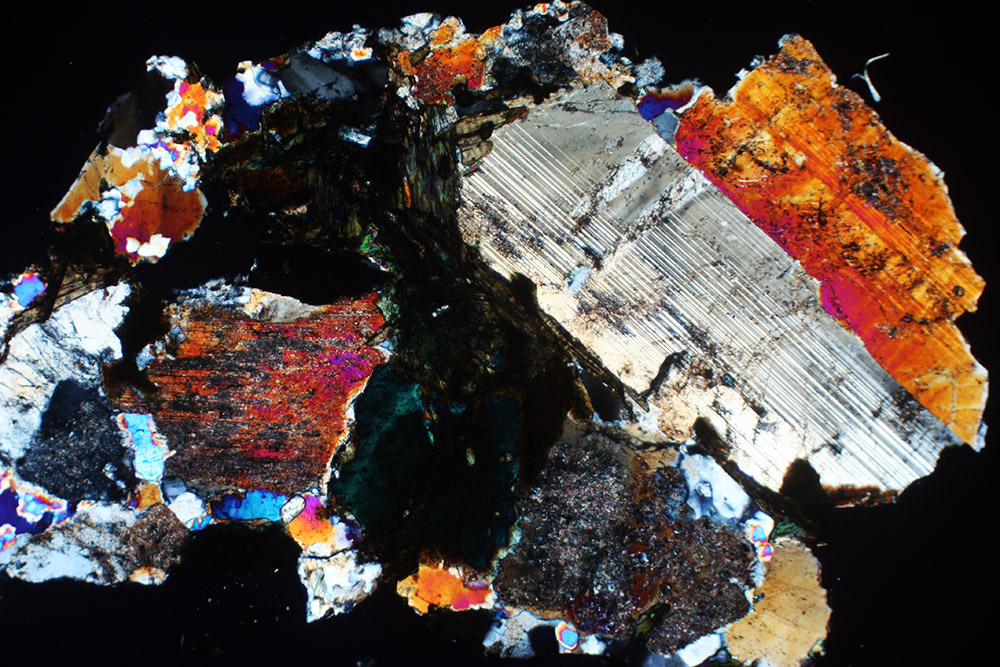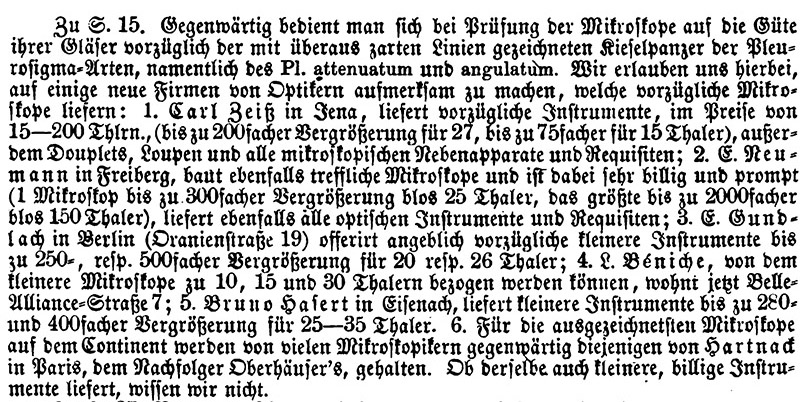
Figure 1. Two circa 1870 microscope slides by Ernst Neumann.
Ernst Neumann, active ca. 1854 - ca. 1880
by Brian Stevenson
last updated February, 2021
E. Neumann produced high-quality microscope slides in Freiberg, Saxony (Germany). They were primarily thin-sections of geological specimens, but he is also known to have mounted diatoms, histological specimens, and crystals for polariscope viewing (Figure 1). He advertised to provide collections of geological slides, probably designed for students in the renowned Geology Department of the University of Freiberg. J.W. Judd, in a presentation to the Geological Society of London, described Neumann as "one of the earliest makers of microscopic slices of minerals and rocks".
Neumann also made microscopes, and sold a variety of optical equipment. His microscopes are rarely seen, and do not appear to be particularly distinguishable from those of other makers.

Figure 1.
Two circa 1870 microscope slides by Ernst Neumann.

Figure 2.
Photomicrograph of a thin-section of syenite, obtained from Auerbach, Hesse, and prepared by E. Neumann (see Figure 1). Photographed with a 3.5x objective lens and crossed polarizing filters, with a C-mounted digital SLR camera.
Little is known about Ernst Neumann's life. The earliest known record of Neumann is his listing in the 1855 Adressbuch of Freiberg (Figure 3). He was not listed in the 1853 edition, suggesting that Neumann opened his business around 1854. The 1855 listing gave his name as Ernst Friedrich, working as a "mechanikus" near the Military Hospital. The next readily available Adressbuch, from 1876, gave his name as Friedrich Ernst Neumann.
The 1873 Neues Jahrbuch für Mineralogie, Geologie und Paläontologie wrote that, "Mr. E. Neumann, mechanic in Freiberg, Saxony, recommends his thin sections of rocks and minerals". The 1874 Jahreshefte des Vereins für Vaterländische Naturkunde in Würtemberg noted that, "E. Neumann, mechanic in Freiberg, Saxony, prepares a large number (his latest catalogue includes 50 stone and 18 mineral slices), each for 7 1/2 Silbergroschen (50 slides in a box for 13 Thalers)". The 1871 edition of Moritz Willkomm's Die Wunder des Mikroskops stated that, "One can obtain excellent preparations of diatoms, as well as comparative anatomy of animals, from E. Neumann (mechanic and optician in Freiberg)".
Geologist John W. Judd wrote in 1893, "More than twenty years ago, when visiting Freiberg, I obtained from E. Neumann, an optician in that town, who was one of the earliest makers of microscopic slices of minerals and rocks, a thin section which at the time arrested my attention and has often since been referred to with interest. It bore the label Dopp. geschm. Porphyr, Grillenburg; but the maker of the section was unable to afford me any information concerning the origin of the specimen or the authority on which it had been described as a doubly-melted porphyry. The microscopic examination of the specimen, however, seemed to indicate that it had been correctly labelled, and that it was indeed a rock of very considerable interest … For a long time I was quite foiled in my endeavours to obtain any trustworthy information concerning this remarkable specimen of the source from whence it was derived, or the authority on which it was labelled. Some time ago, however, Prof. Zirkel and Prof. Credner kindly interested themselves in the matter, and as a consequence of the communications which they have made to me I have been enabled to clear up my doubts on the subject. The specimen must evidently have been obtained, not from the locality named, but from Ascherhübel, which lies about 3 kilometres north of a village now known officially as Grüllenburg, but which was formerly called Grillenburg". Judd's comments provide insights on Neumann's training and occupation. Neumann was unable to provide information on why the specimen was labeled as such, indicating that he had limited knowledge of geology. Furthermore, Neumann did not know the origin of his specimen, indicating that he did not collect it himself. Thus, Neumann prepared thin-section slides of geological specimens that were provided by others, probably geologists at the University.
The 1866 edition of Willkomm's Die Wunder des Mikroskops includes an appendix of late additions, which included several microscope manufacturers who had been omitted from the main body of text. This list included "E. Neumann in Freiberg" who "builds excellent microscopes and is very cheap and prompt …(and) also supplies all optical instruments and apparatus" (Figure 4). Later editions listed Neumann in the main body. An 1874 catalogue of apparatus in Saxony schools included a microscope, polarization apparatus, and tourmaline tongs by Neumann. His microscopes are rarely seen nowadays, suggesting a fairly limited level of production and distribution.
Ernst Neumann was not included in the 1886 Freiberg Adressbuch, suggesting that he had retired between 1876 and 1886. Instead, an Alexander Neumann was working as an "optikus" (Figure 3). Alexander was not included in the earlier address books, suggesting that he began his shop between 1876 and 1886. It is logical to assume that Alexander had taken over Ernst's business, and may have been his son. Later address books give Alexander's middle name as Hugo.

Figure 3.
Excerpts from Freiberg address books. Ernst Neumann was listed in the 1855 and 1876 editions, but not the 1886 edition, suggesting that he retired between the 1876 and 1886. Alexander Neumann, "optikus" first appeared in the 1886 edition - his surname and profession suggest that Alexander was Ernst's heir, possibly his son.

Figure 4.
Appendix of additions to the 1866 edition of Moritz Willkomm's "Die Wunder des Mikroskops" listed several microscope manufacturers who had been omitted from the main body of text. Ernst Neumann was listed alongside Karl Zeiss, Ernst Gundlach, and others. Neumann's microscopes are rarely seen these days, and those that are known are unremarkable, suggesting that Neumann produced plain, inexpensive instruments in fairly small numbers.
Acknowledgements
Thank you to Timo Mappes and Joe Zeligs for helpful conversations and insights on Ernst Neumann's microscopes.
Resources
Astronomische Nachrichten (1875) Advertisement from E. Neumann, Vol. 85, page 47
Historische Adressbücher (accessed February, 2021) https://adressbuecher.sachsendigital.de/suchergebnisse/adressbuch/Book/list/freiberg/1855/
Jahreshefte des Vereins für Vaterländische Naturkunde in Würtemberg (1874) E. Schweizerbart, Stuttgart, page 33
Judd, John W. (1893) On the inclusions of tertiary granite in the gabbro of the Cuillin Hills, Skye, The Quarterly Journal of the Geological Society of London, pages 175-178
Neues Jahrbuch für Mineralogie, Geologie und Paläontologie (1873) E. Schweizerbart, Stuttgart, page 672
Ruehlmann, R. (1874) Katalog der Physikalischen Normalsammlung sächsischer Gymnasien, Realschulen und Seminare, Zeitschrift für Mathematischen und Naturwissenschaftlichen, pages 159-165
Willkomm, Moritz (1866) Die Wunder des Mikroskops, Otto Spamer, Leipzig, page 308
Willkomm, Moritz (1871) Die Wunder des Mikroskops, Otto Spamer, Leipzig, page 20
Willkomm, Moritz (1878) Die Wunder des Mikroskops, Otto Spamer, Leipzig, page 15